“Hope” is the thing with feathers –
That perches in the soul –
And sings the tune without the words –
And never stops — at all –And sweetest — in the Gale — is heard –
And sore must be the storm –
That could abash the little Bird
That kept so many warm –I’ve heard it in the chillest land –
And on the strangest Sea –
Yet, never, in Extremity,
It asked a crumb — of Me.
Here’s a routine that’s caused me a thousand arrhythmias in the past few days:
Scores of American Robins descend on berry shrubs that line the main route through our neighborhood. The robins cram as many berries as possible into their crops. And then, whenever a truck, bus or SUV rumbles toward the shrubs, they flush right into the road, right in the path of the vehicles over-driving the speed limit. The birds do this all at once … so the scene is one of chaos … of robins banking left right and every which way as they use updrafts to [barely] avoid the vehicles.
[Note the background sound of a truck on approach, as the robin in this video ditches out.]
To photograph these robins, I’ve been using my car as a blind, parked across the street from a stand of what I believe are pyracantha berries. Last year, I shot my robin-berry images after a snowstorm when people were sledding, not driving. This year, it’s become a harrowing event for a bird lover like myself, so much so that I stopped shooting and kept vigil for a while, making sure none of the robins were hit or injured. A few robins got a light grazing before swinging up to the trees to recover. Noting those incidents, Hugh and I now comb the area at the end of each day to make sure there’s no one left behind with an injury.
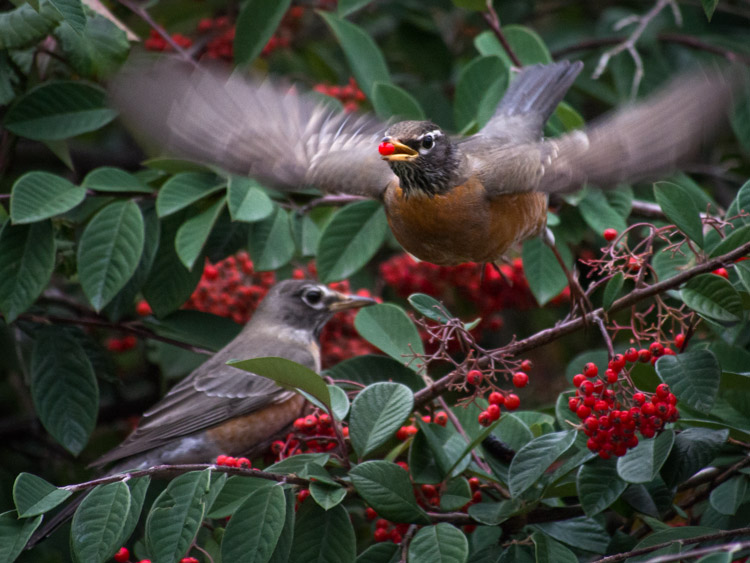
Road hazards notwithstanding, I love the bird-berry rituals each winter. In Oakland, it was the Cedar Waxwings who heralded the official start of winter when they raided our holly and pyracantha trees. Here, it’s huge flocks of American Robins, interspersed with Starlings and an occasional Cedar Waxwing. It’s the joy I perceive in these frenzies that draws me in. It looks like bird bliss when they discover these troves of red treasures.
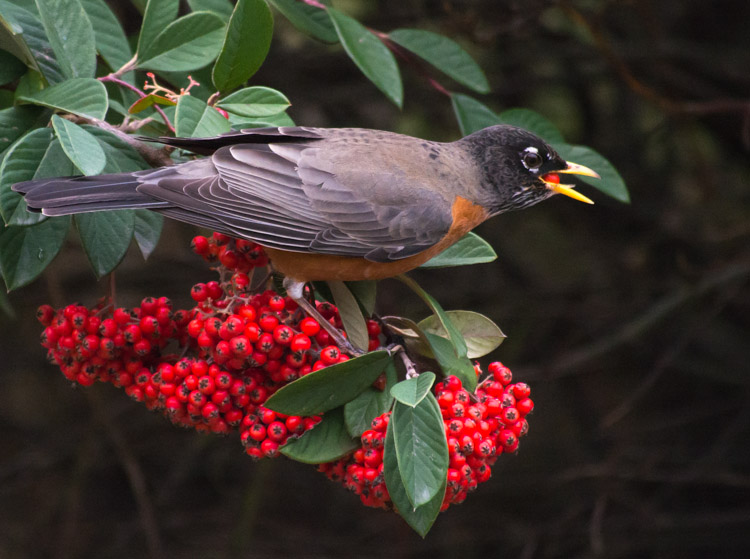
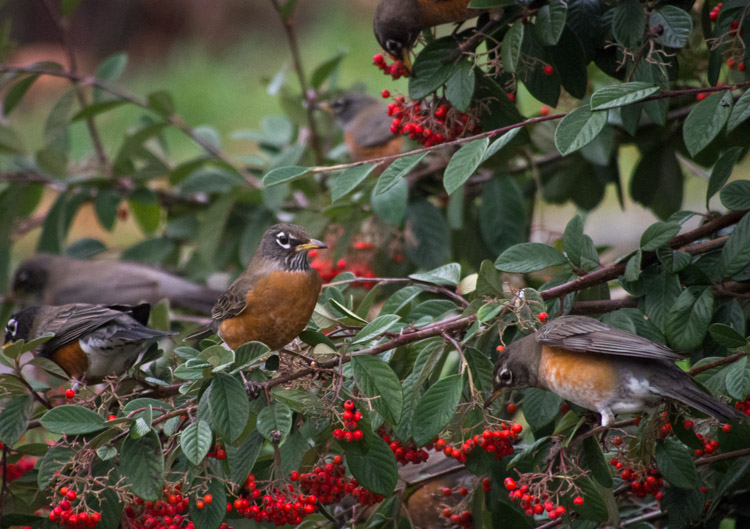
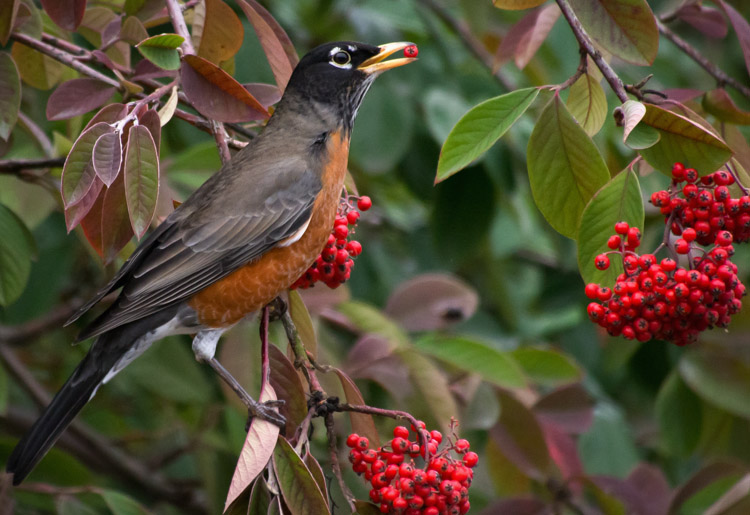
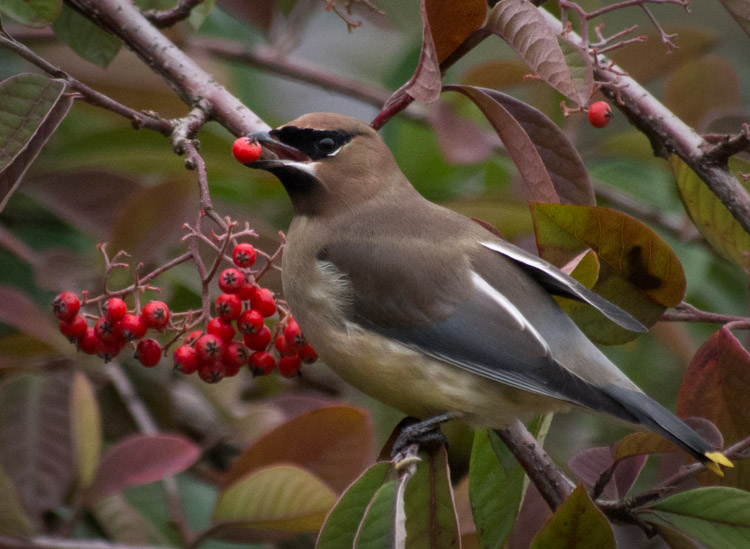
The main diet for wintering robins is fruit-based. Berries like pyracantha, hawthorn, holly, and juniper meet digestive juices in the stomach’s proventriculus at the front end, then transport their seeds through the bird’s system for deposit and germination later.
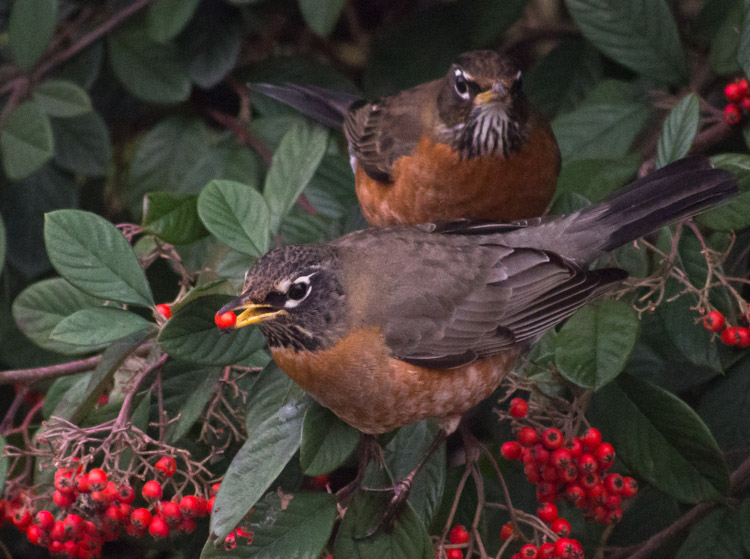
Once the soil thaws in the north, bringing worms up from their wintering burrows, American Robins signal spring as they follow migrations northward along the 37 degree isotherm (that is, zones where the average temperature is 37 degrees F). They exploit the snow melts and rains which flood the worm holes and bring their spring and summer protein sources to the surface.
Then, throughout spring they feed their youngsters insects, worms and other small invertebrates … until autumn when the soil grows cold and impenetrable again. Next year, as every year, January will bring flocks of American Robins scanning the neighborhood for the red nourishment that ripens on the same timetable that drives their own travels and toils.
These photos were shot with the Olympus OM-D E-M5 and a Lumix 100-300mm lens. The days have been dark so the ISO on many of these images is 2000+, with a bit of NR applied in post processing.
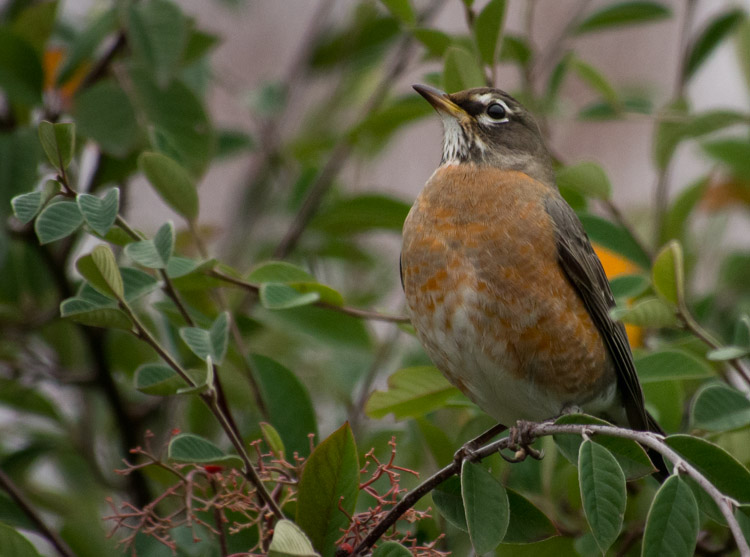

Wow, that was a gluttonous robin in the clip! I overlook this species as a subject for my photography much too often and these photos reminded me of that. You’ve done a fine job with them here, Ingrid and I loved your “Token Waxwing” too. The “37 degree isotherm” is new to me – always something new to learn.
Ron, sometimes for me it’s simply a matter of practicality. I often have to shoot close to home, so I’ve come to genuinely love and appreciate my common and urban birds … and the variations in their behavior. Send me a note if you end up photographing robins because I can only imagine how stellar the representations will be!
I never knew about the 37 degree isotherm either, very interesting!
Love these images and the information you provided Ingrid
Mia … and I didn’t know how deep earthworms have to burrow in order to survive cold weather! It’s such a fascinating and lovely perfection, if you ask me.
The video and images are very nice, and the 37 degree isotherm is a phenomena to learn. Thanks!
I didn’t say anything about Emily Dickinson’s poem. What a gift this lady had for simplifying vocabulary and poetry. Such few words for such ample meanings. Thanks for that one!
Maria, I thought of Dickinson because of her poem, “The Robin” (https://bit.ly/Vigpg8). But then, as I browsed, reminded of her other poems, I realized how often she referenced birds, and in a loving and reverential way.
I read a short biography of Dickinson’s work the other day, and she had to endure a lot of suffering due to publishers not being able to understand her style (her dashes and particular use of grammar). Her work was misinterpreted, but all along she knew what she was doing. She is now considered to be the precursor of a pre-modernist style of writing poetry.
I read “The Robin”, but I like “The Thing with Feathers” as the header of this post.
Thanks for that information. I had the cursory exposure to Dickinson when I was younger, not much more. I’m now interested to read about her travails in publishing and in life. And yes, the phrasing, “hope is the thing with feathers” spoke to my spiritual inclinations, over my literal ones.
How grateful I am to discover your beautiful, informative, inspiring blog through your comment on Earth in Transition.
Even without the dangerous traffic, my heart would have been in my throat if I’d captured a photo like “The Fly Out!” This whole collection of photos is wonderful and special, but that one is a standout. And, being especially partial to Waxwings, I love that one is represented here.
I also love Emily Dickenson, and what a perfect poem to accompany your photos! I’m going to enjoy looking back through your archives (and am now following). Thank you for watching out for the safety of our bird friends, and for capturing them so beautifully in your photos and sharing them on your blog.
Laloofah, thank you so much … for this kind comment and also for the perspective you provided at Earth in Transition. It’s a joy and relief to meet other individuals who share these sentiments about our non-human kind.
I know what you mean about waxwings. They are among my favorite birds, too, and my fondness grew deeper when we treated them in the wildlife hospital where my husband and I worked. Cedar Waxwings are so quick to flush (like Robins) that window strikes are quite common for them. We’d treat them with anti-inflammatory medications, and they were among the easiest to medicate because they would snap and open their beaks. It was endearing to me, even though I know for them, they would have chosen to be anywhere but a recuperating ward.
This must be bird-appreciation day for me! I was just reminded on another blog of the song Who Will Love A Little Sparrow by Simon and Garfunkel https://www.youtube.com/watch?feature=player_embedded&v=0eWaG1gXnwQ
As these masters of words and song have eloquently portrayed the plight and beauty of these “things with feathers” – You certainly have done so in imagery. Absolutely stunning! Thank you for sharing what your keen eye, talents and caring heart have accomplished.
Bea, thank you! I’d totally forgotten about that song. I played it a few times after following your link. My husband Hugh and I were saying the other day that it’s so difficult for us to understand how some people cannot like or appreciate birds. I mean, one obviously has to account for personal differences. But, even if one isn’t enamored with animals the way I am, birds are simply miraculous and ethereal beings. It’s not just their gift of flight. It’s the complexity of their behavior and their existence that draws me into adoration. When you think that migrating birds, as one example, shrink their reproductive organs to be aerodynamically prepared for distance flight … that hummingbirds are designed for tubular plants … that owls’ wings are shaped to alight in complete silence … these are just a few samples of bird magic that will enthrall me to my end of days. And … that’s not even counting the four-leggeds, furry people, crawlers and swimmers among us.
Fantastic shots!
Many thanks. I hope that in five years time I can look back at today’s work and think … wow, I didn’t know anything back then.